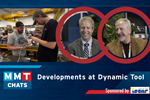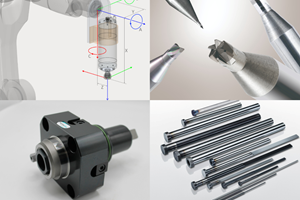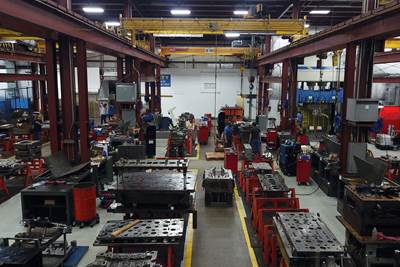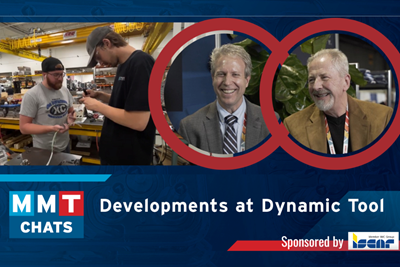
Decatur Mold Tool & Engineering’s newly completed Tech Center features three automation cells dedicated to mold manufacturing. Each cell is equipped with an independent robot that services one or two machines. Source | Decatur Mold Tool & Engineering.
Let’s start with a few obvious advantages of implementing automation in the moldmaking process. More specifically, the benefits that immediately came to mind when discussing automation with Decatur Mold Tool & Engineering (North Vernon, IN) and Dynamic Tool Corp. (Menomonee Falls, WI).
Machine utilization is a significant advantage of automation, as multiple blocks can be set up and loaded into a machine or automation cell, enabling continued operation even when the facility is unoccupied. While full automation of block loading and unloading isn't yet implemented in all cases, partial automation has been achieved.
For instance, once a part is picked up in one machine platform, that offset information can be utilized when moving to another platform, such as a CMM. In some circumstances, probing programs can be created to automatically pick up multiple parts, though this isn't always feasible due to factors like geometry, quantity or other variables that may affect the time-related payback.
Additional benefits include utilizing unmanned hours, increasing throughput and expanding capacity without adding employees or spindles. Both shops agree automation has improved efficiency while maintaining quality standards. It has also created opportunities for career advancement. Since employees no longer spend time moving and resetting blocks for subsequent machining phases and inspection, they can focus on the technical aspects of mold manufacturing.
For example, Dynamic Tool Corp. uses its highly skilled employees’ knowledge and machining experience in parallel with its automation technology's functionality and capabilities. “In return, they produce mold components with greater speed, accuracy and repeatability — which are critical in the manufacture of high-cavitation, tight-tolerance injection molds,” says the company’s New Business Development Manager, John Berg.
Decatur Mold started to look at the whole process from a new perspective. This step enhanced the teams’ ability to think outside the box and use critical thinking to solve problems in a way that does support the shops’ vision.
Integration Challenges
Injection moldmaking is different from general machining or high-volume production work. It is easier to automate the production process for simple geometry or high-capacity runs; the challenge with automation in moldmaking is diversity in components — size, shape and geometric complexity.
Dynamic Tool Corp. graphite cells enable users to email tool life warnings, alarms and status updates while waiting for the robot to change tools. Source | Dynamic Tool Corp.
“Finding a one-size-fits-all (or most) solution in workholding, machining, programming and equipment platforms is more challenging, requiring well-thought-out and systematic internal processes as well as procedures,” says Berg.
Application decision. Step one is deciding how to use automation and what you want to achieve by integrating it into your environment. Automation can be as simple as a tool changer or as complex as a multi-machine linear line. Once decided, the obstacles will rise to the surface.
“For example, after the decision to have individual robotic cells, we faced two challenges: space and training. The saying ‘You can’t know what you don’t know’ is very applicable when implementing a new way of manufacturing and producing injection molds. How could we know what we needed, or more importantly, what we didn’t?” says Decatur Mold Director of Operational Efficiency, Louie Fields.
Mind-shift change. Then, there is the impact automation has on employees. It can be career-changing, says Fields, because being unmanned demands a change in the way the team approaches work from almost every aspect of a mold build.
Decatur noticed the traditional ways of manufacturing a mold didn’t support the shop’s vision or automation investment, so the company discarded 80% of what it had done in the past and started to look at the whole process from a new perspective. This step enhanced the teams’ ability to think outside the box and use critical thinking to solve problems in a way that does support the shops’ vision.
Fields believes that if you want to integrate automation in your shop, you must be willing to accept that what you have done in the past will most likely not support your vision of the future. “You must keep an open mind because what doesn’t seem practical in a manned machine operation may be the best approach when using automation,” says Fields.
For example, Fields describes how Decatur machines small inserts. In the past, the company would set up as many as possible on a block and run the machine lights out, which greatly improved spindle hours. The team viewed this process differently when they introduced automation into the operation.
While roughing a group of hardened Mirax inserts in a cluster, the team noticed they had to use multiple roughing paths and space out the inserts that used extra material. By automating how it changed out the parts, the company discovered setting up single inserts on the pallets reduced roughing time, decreased the number of necessary cutting tools and lessened the material, yielding shorter cycle times and truly achieving unmanned spindle hours.
When integrating automation, don’t be naïve and think there won’t be a few hiccups along the way — because there will be. Fields recommends leaning on your machine manufacturer to set everything up and working with a single point-of-contact to overcome the challenges associated with the software and hardware devices involved in automation.

Automation in Action
The options for equipment and machinery that can bring automation to mold production are plentiful, as are the benefits. For example, Dynamic Tool’s automated sinker EDM cell has greatly increased the capacity of its EDM department without increasing personnel or equipment numbers.
“Our throughput has also increased considerably while maintaining and improving repeatable quality output. This is achieved by adding offline programming and simulations for both sinker EDM operations and CMM inspection along with an integrated cleaning station in the cell,” says Berg. The company’s graphite cutting cell and hard-cutting cell also integrate metrology with machining and workpiece management. As a result, it no longer needs to manually take parts in and out of the cell for metrology and cleaning, as these are now completed inside the cell via automation.
Dynamic Tool’s CNC Specialist, Dennis Barkow. points out, “In the graphite cell, we use Makino D200z and V33i machines. These machines can email tool life warnings, alarms and status updates when waiting for the robot to change tools. This feature enables employees to monitor the machines' status 24 hours a day, seven days a week.”

One cell at Dynamic Tool includes 30 12 × 12 pallets and four electrode carousels, for a total of 800 electrode positions, which can be expanded further in the future. Source | Dynamic Tool Corp.
Before the investment in designing and building its automated hard-cutter cell, pallets with parts on them were frequently hand-loaded in and out of the machines to go to the CMM lab. By integrating the CMM into the cell and creating a system where all the machines are fed by one robot, the need to handle parts manually was removed.
“We can now get dimensional results and adjust for them without having to move the steel manually. We can also run the CMM lights out, whereas before, we had an employee running the machine. Our cell employees now have a better understanding of the metrology process and instead of needing to communicate their measurement needs, they can check them themselves in an unattended process. Delivering quality products is one of our core values, and having quality checks on components incorporated into the manufacturing process is important to help us deliver that value,” says Berg.
Over at Decatur, a recently completed Tech Center houses three automation cells for its mold manufacturing process. Each cell has an independent robot servicing one or two machines. An EDM cell was its first automation project. It involves an Erowa Robot Dynamic 500 with over 300 storage positions for electrodes and small pallet work. It can hold six MTS 500 pallets for core and cavity inserts. This system enables Decatur to continuously run, cutting graphite on the Makino D200Z five-axis machine while loading pallets on the table and electrodes in the quill in a Makino EDNC 8 EDM.
Next is the company’s five-axis machining cell, employing a FANUC M900 robot and one Makino D500 five-axis milling center for complex mold machining. This cell can hold 28 Erowa ITS pallets and 24 MTS 500 pallets and is controlled by Makino’s MAS-A5 (Makino Advanced System) cell controller, which collects all the tool data from a Zoller tool presetter.
“As we set up our tooling, it also ensures we have our posted paths for the project and uses our verification files to ensure a safe and seamless operation,” says Fields.
The safeguards built into the Makino controller reduce the human error factor, enabling the automation to function as designed and the process to operate seamlessly even when employees are away from the facility.
These two cells complement each other in using the same pallet system, providing a seamless handoff from machine to EDM. “No need to re-fixture the workpiece. We can remove the pallet from the D500 cell and load it in the EDM cell and be ready to burn in under five minutes,” says Fields.
Decaturs’ third automation cell is its largest. It encompasses a FANUC M2000Ia/1200 robot servicing two Makino D800Z five-axis machines. This cell can hold 24 pallets, has a square workpiece size of 27″ x 27″ x 15″ and has a maximum weight of 2,255 pounds.
Decatur’s first “automated” project was a single-cavity, H-13 mold that produced a 2-inch-diameter connecting tube. The internal part shape was formed by two S-7 slides that created a right angle in the part.
“Despite starting this project using a new process, new equipment and new automation, it went as smooth as you would imagine with the variables we faced. However, we did prove that producing a mold and its components is possible with a true unmanned approach. The mold was completed on time with little to no fitting and produced parts that required no after-sample work,” says Fields.
“Our throughput has increased considerably while maintaining and improving repeatable quality output. This is achieved by adding offline programming and simulations both for the sinker EDM operations and CMM inspection along with an integrated cleaning station in the cell.”
Ancillary Automation
Dynamic Tool uses automated workpiece management in its hard-cutting, graphite cutting and sinker EDM cells via a track-mounted robot integrated into the machining centers, workpiece storage racks and CMM. These systems help to produce mold components to specifications, validate the operations and document the results.
“Machinery manufacturers such as Makino and Yasda take automated workpiece handling into account and design machine centers with appropriate access and integration,” says Berg.

Dynamic Tool specialists not only program the EDM, but also program the robot and the CMM — it’s the whole cell. Source | Dynamic Tool Corp.
The introduction of Dynamic’s automated cells has reduced the processes and setups needed to manufacture any given component — saving time while increasing the teams’ ability to maintain and validate quality targets.
“If needed, any of the machines in either of our completed cells can also be used in standalone mode,” says Berg.
An ancillary component to Decatur’s goal to run unmanned requires a way to fill its sumps 24 hours a day, seven days a week. To achieve this, the team uses a FlexxCool automated coolant filling system, which continuously monitors and fills the machines to the correct level while maintaining the right coolant concentration. This investment removes one more interaction with the machine.
Another item is the coolant itself. Decatur’s automation cells use a carbon nano onion-based coolant (ToolX) that reveals some promising results when processing hard materials like Mirax at 50 HRC. “We can drill, tap and rough this material, which is generally not done in the hardened state,” says Fields.
Software Solution
Software plays a significant role in automating design and simulation processes. The software a shop uses dictates the level of efficiency and accuracy a shop can achieve within its manufacturing process, including scheduling and fixture management. To design its molds, Decatur uses NX, whose Mold Wizard feature helps to standardize the mold designs for automation.
The company also use Makino’s ED CAM software to program its EDM automation. “We no longer have to create location forms or have an operator manually enter each burn location at the controller. Everything is offline, which enhances our efficiency and eliminates the risk of ‘fat fingering a number’ while manually entering locations,” says Fields.
Berg notes while some off-the-shelf programs are available, Dynamic Tool created and continues to create its own programs for its automated cells, which more appropriately suit its needs and facilitate the scope and expansion in planning.
Embracing Automation for Success
Automation in moldmaking offers numerous advantages, from increased machine utilization and efficiency to career advancement opportunities for employees. While implementing automation poses challenges such as finding versatile solutions for diverse components and adapting to new processes, the benefits are significant. Companies like Decatur Mold and Dynamic Tool have successfully integrated automated cells, robotic systems and specialized software into its operations, resulting in improved throughput, quality and capacity. As the industry continues to evolve, automation is proving to be a game-changer in moldmaking, enabling shops to meet demanding production requirements while fostering innovation and skill development among the workforce.
Related Content
Technology Roundup: New/Improved Technologies You Don't Want to Miss
With all the technology joining the market, moldmaking is a versatile, ever-evolving industry. As such, this technology roundup has no specific theme — it features a variety of products for applications and solutions across the industry.
Read MoreHow to Automate Process and Design
Moldmakers can improve their operations and stop wasting time by taking these six steps for process and design automation.
Read MoreMold Builder Meets Increased Domestic Demand With Automated Cells
Burteck LLC experienced significant demand increases due to reshoring and invested in automated machining cells to step up its production output quickly and avoid losing business.
Read MoreAchieving Flexible Capacity with Automation
This high-mix, low-volume manufacturer embarked on a year and a half program to introduce robotics to its manufacturing process.
Read MoreRead Next
Indiana Mold Builder Decatur Mold Offers a History of Grit and a Future of Innovation
Decatur Mold Tool and Engineering Inc. serves as a tooling tour guide, helping busy tooling managers reduce uncertainty, lighten workload.
Read MoreSnapshot of Why Dynamic Tool Corp. is MMT's 2024 Leadtime Leader Winner
Here is a quick look at some of the reasons this 40-plus-year-old engineered tooling solutions provider took the title this year.
Read MoreMMT Chats: Developments at Dynamic Tool
This Dynamic Tool Duo sits down with MoldMaking Technology Editorial Director Christina Fuges to share some company news as well as updates on the shop’s workforce development efforts and technology investments. This episode is brought to you by ISCAR with New Ideas for Machining Intelligently.
Read More























